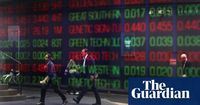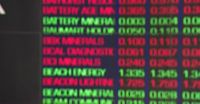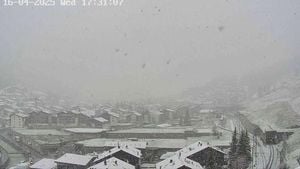The White House today announced that tariffs on imports from China would increase to an astounding 104 percent from 2 PM AEST today. Following this, the ASX 200 dropped 2 percent to 7349 when trading opened at 10 AM. Mineral stocks have once again been one of the big losers. While Australia stands to suffer little direct effect from the 10 percent US tariff levelled on our imports, the heavier levies on Asian imports could hurt locally.
"Beijing is pledging to 'fight to the end', which doesn't spell good news for markets," eToro market analyst Josh Gilbert said. "The unfortunate part of that is that if China sneezes, Australia is likely to catch a cold." Gilbert said the prospects for the dollar were not good. "China is Australia's largest trading partner, and the fortunes of the AUD are closely tied to those of the Chinese economy," he said. "For now, uncertainty and volatility will remain high, recession chatter will continue, keeping risk assets under pressure until we get clearer direction on tariffs, negotiations, and central bank moves."
Investors piled back into Australian shares on Tuesday, ignoring a looming showdown between the US and China in a tariff battle that threatens to paralyse global trade. The benchmark S&P/ASX 200 closed up more than 2 percent, representing its biggest one-day gain in more than two years. The rebound erased some of the steep losses suffered on Monday when the share market recorded its worst session in five years, down by more than 4 percent.
The ASX reprieve comes ahead of an important juncture, given Donald Trump has issued a fresh threat to raise his tariffs on China by an additional 50 percent from April 9 if Beijing doesn’t withdraw its own retaliatory tariffs. In response, China’s commerce ministry has vowed to fight US tariffs "to the end". Fund managers have told Guardian Australia they are looking for signs of a truce in the tariff tit-for-tat to signal that a sustained recovery in equities may be on the cards.
Chris Weston, the head of research at Pepperstone, said on Tuesday that Trump’s fresh tariff threat against China was a risk for traders and "should heighten the wall that the market needs to climb". While the details of Trump’s "liberation day" initially spooked investors, the retaliatory tariffs from major trading nations and blocs like China and the EU triggered market panic. Traders have been weighing up whether Trump is using the threat of tariffs to cut deals or whether they will be locked into place this week, reordering global trade.
There is growing concern that if the latter occurs, a "full-blown trade war, imminent recession and a liquidity crunch last seen during the early pandemic" may ensue, according to IG analysts. Meanwhile, the Australian share market is being pulled and pushed by international forces, and was led higher on Tuesday by the US futures market. Australia’s benchmark closed at 7,510 points on Tuesday, up 2.3 percent, marking a shift in sentiment that saw share prices collapse the day before.
The Australian dollar was trading at US60.5 cents late on Tuesday afternoon, representing a robust rebound for the day, albeit still significantly lower than the 64-cent mark it reached last week before Trump’s tariff announcements roiled markets. A weaker currency is generally bad for Australian travellers and consumers buying overseas goods, but positive for exporters. The Australian dollar has close links to commodity prices, particularly iron ore, which would suffer if global economic activity slowed, especially in China.
While the market ruptures have caught many traders by surprise, State Street Global Advisors data shows that long-term institutional investors had reduced their exposure to shares last month ahead of the "liberation day" tariff announcement. "Investor caution prompted a further retracement out of equities and into bonds and cash in approximately equal increments," the State Street economist and market strategist Dwyfor Evans said on Tuesday.
Investors typically limit risk in their portfolios by allocating more of their portfolio to cash and fixed income, while reducing exposure to more volatile assets like equities. The S&P/ASX 200 closed 166.7 points higher, up 2.27 percent on April 8, 2025, following a rough trading session the day before.
In the broader-based S&P/ASX 300, advancers beat decliners by a resounding 258 to 25 on April 8, 2025. Westpac Consumer Sentiment for April fell to -6.0 percent from +3.7 percent in March, reflecting growing concerns among consumers. Similarly, NAB Business Confidence for March dipped by 1 point to -3 points, indicating a decline in business sentiment as well.
As the market navigates these turbulent waters, analysts remain cautious yet hopeful. The recent fluctuations have underscored the interconnectedness of global economies and the potential fallout from escalating trade tensions. Investors are left to wonder if a truce can be reached, or if the markets will continue to experience volatility as they react to the unfolding events.
In summary, the current economic landscape is marked by uncertainty and potential for significant shifts. The interplay between US tariffs and Chinese responses will likely dictate market movements in the coming days, making it a critical time for investors to stay informed and agile in their strategies.






